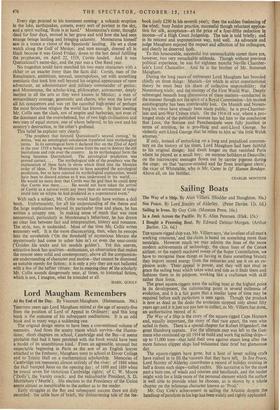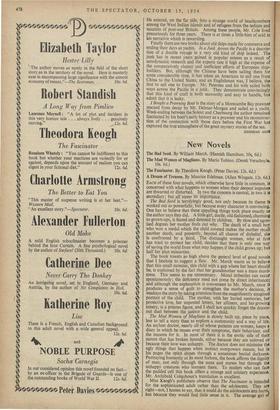Sailing Boats
In a Junk Across the Pacific. By E. Allen Petersen. (Elek. 15s.) THE square-rigged ship was, Mr. Villiers says,' the loveliest of all man's working creations,' and the claim is based on something more than nostalgia. However much we may admire the lines of the more modern achievements of technology, the clean lines of the Comet airliner, or the superb mackerel sweep of the Super Constellation, we have to recognise these things as having in them something brutall they import stored energy from the refineries and use it on an ex- plosive scale. Their appeal is power, and they will not rival in grace the sailing boat which takes wind and tide as it finds them and fashions them to its purpose, working like a craftsman with skill rather than force.
The great square-riggers were the sailing boat at the highest point in its development, the culminating point in several millennia of evolution, and it is a fair guess that a similar lapse of time may be required before such perfection is seen again. Though the product is now as dead as the dodo the evolution stopped only about fifty years ago and it is just not too late to collect, as Mr. Villiers has done, an authoritative record of it.
The Way of a Ship is the story of the square-rigged Cape Homers and, equally important, the story of that race apart, the men who sailed in them. There is a special chapter for Robert Hilgendorf, the great Hamburg captain. For the ultimate step was left to the Ger- mans who continued up till 1914 to build and work big sailing ships— up to 11,000 tons—that held their own against steam long after the more famous clipper ships had-exhausted their brief but glamorous day. The square-riggers have gone, but a host of lesser sailing craft have rushed in to fill the vacuum that they have left, In Sea Peace, Lord Stanley of Alderley contributes a record of holiday cruising in half a dozen such ships—called yachts. His narrative is for the most part a bare one, of winds and courses and headlands, and the reader might wish for a little more of the personal element which the author is well able to provide when he chooses, as is shown by a whole chapter on the infamous character known as Prod.' Mr. Guy Cole's achievement in sailing the Atlantic despite the handicap of paralysis in his legs has been widely and rightly applauded He entered, on the far side, into a strange world of beachcombers among the West Indian islands and of refugees from the tedium and taxation of post-war Britain. Among these people, Mr. Cole lived precariously for three years. There is at times a little hint of acid in his narrative which is rewarding.
Finally there are two books about old ships made for commerce and ending their days as yachts. In a Junk Across the Pacific is a descrip- tion of a double voyage in a very old kind of ship indeed. The junk has in recent years gained in popular esteem as a result of aerodynamic research and the experts rate it high at the expense of the comparatively clumsy and inefficient efforts of European ship- builders. But, although the Chinese have been sailing them for some considerable time, it has taken an American to sail one from China to the United States, and an Englishman was, I believe, the- first to sail one to Europe. Mr. Petersen and his wife sailed both ways across the Pacific in a junk. They demonstrate convincingly that this kind of craft is both seaworthy and easy to handle, but admit that it is leaky.
I Bought a Prawning Boat is the story of a Morecambe Bay prawner rescued from decay by Mr. Delmar-Morgan and sailed as a yacht. Week-ending between the Solent and Cherbourg the author remained fascinated by his boat's early history as a prawner and his reconstruc- tion of the connection with those days before the First War has captured the true atmosphere of the great mystery stories of the sea.
JEREMIAH ASH/



































 Previous page
Previous page